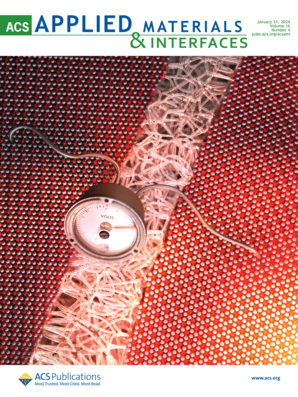Hydrogen Isotope (1H/2H/3H) Separation in Solution Using Graphene Transferred on PTFE-Reinforced Nafion.
IF 8.3
2区 材料科学
Q1 MATERIALS SCIENCE, MULTIDISCIPLINARY
引用次数: 0
Abstract
The separation and enrichment of tritium from radioactive wastewater remain critical challenges in the nuclear power and fusion industries. While hydrogen isotope separation from H2/D2 gas mixtures has been demonstrated using electrochemical pumping systems with Nafion|graphene composite membranes, their application in liquid water remains limited, despite tritium and deuterium predominantly existing as water molecules. This limitation primarily arises from the swelling behavior of Nafion, which absorbs water and induces defects in the graphene layer. In this study, we propose a modified Nafion|graphene composite membrane structure, where graphene is transferred onto polytetrafluoroethylene-reinforced Nafion, to enable efficient hydrogen isotope (1H, 2H, and 3H) separation in liquid water. The monolayer graphene exhibited six-fold higher conductivity for H+ over D+ under electrically driven conditions, while diffusion-driven transport showed lower isotope selectivity due to the contribution of the vehicular mechanism. Notably, graphene imposed a 1.7-fold higher diffusion energy barrier for tritium than for deuterium, indicating that the separation is governed by zero-point energy differences in O-H(D, T)···O bonding. These results highlight the role of transport mechanism and graphene integrity in isotope separation performance and suggest a practical pathway toward implementing graphene-based membranes in polymer electrolyte membrane water electrolysis systems for tritium concentration and removal.聚四氟乙烯增强Nafion上转移石墨烯分离溶液中氢同位素(1H/2H/3H)。
从放射性废水中分离和富集氚仍然是核电和核聚变工业面临的重大挑战。虽然利用电化学泵送系统与Nafion|石墨烯复合膜可以从H2/D2气体混合物中分离出氢同位素,但它们在液态水中的应用仍然有限,尽管氚和氘主要以水分子的形式存在。这种限制主要是由于Nafion的膨胀行为,它吸收水并在石墨烯层中引起缺陷。在这项研究中,我们提出了一种改进的Nafion|石墨烯复合膜结构,其中石墨烯转移到聚四氟乙烯增强的Nafion上,以实现液态水中氢同位素(1H, 2H和3H)的有效分离。在电驱动条件下,单层石墨烯对H+的电导率比D+高6倍,而扩散驱动的输运由于载体机制的贡献而表现出较低的同位素选择性。值得注意的是,石墨烯对氚施加了比氘高1.7倍的扩散能垒,表明分离是由O- h (D, T)···O键的零点能量差控制的。这些结果强调了传输机制和石墨烯完整性在同位素分离性能中的作用,并为在聚合物电解质膜电解系统中实现石墨烯基膜的氚浓缩和去除提供了一条实用途径。
本文章由计算机程序翻译,如有差异,请以英文原文为准。
求助全文
约1分钟内获得全文
求助全文
来源期刊

ACS Applied Materials & Interfaces
工程技术-材料科学:综合
CiteScore
16.00
自引率
6.30%
发文量
4978
审稿时长
1.8 months
期刊介绍:
ACS Applied Materials & Interfaces is a leading interdisciplinary journal that brings together chemists, engineers, physicists, and biologists to explore the development and utilization of newly-discovered materials and interfacial processes for specific applications. Our journal has experienced remarkable growth since its establishment in 2009, both in terms of the number of articles published and the impact of the research showcased. We are proud to foster a truly global community, with the majority of published articles originating from outside the United States, reflecting the rapid growth of applied research worldwide.
 求助内容:
求助内容: 应助结果提醒方式:
应助结果提醒方式:


